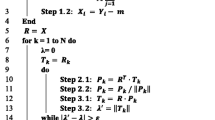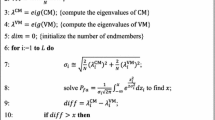Abstract
City Target Detection is an enduring problem that intrigues the researchers all over the world. The great success of existing Target Detection algorithm appears in ubiquitous scenarios: Pedestrian Detection, Vehicle Tracking, etc. However, as for the city target detection in the remote sensing, we are facing with two inevitable problems: Complex Environment and Massive Information. The complicated environment encumbers the accurate extraction of the target profile, and the huge amount of information turns it into a heavy workload to get the final outcome for the conventional CPU- compiler architecture. In this paper, we propose a binary hypothesis framework based on adaptive dictionary and discriminative subspace for hyperspectral city target detection (BHADDS). Furthermore, we have also implemented it on other hardware platform alongside with CPU, such as FPGA. FPGA is a low-power portable and programmble SoC, and also the protocol model for potential massive production of the SoC chipset. Our eventual aim is heading for the high-performance processor with strong instant processing ability for remote sensing. In the final part of the paper, we have given a comprehensive performance comparison over the different platforms and summarized their applicable scenarios.







Similar content being viewed by others
References
An L, Wang W, Shang S, Li Q, Zhang X (2018) Efficient task assignment in spatial crowdsourcing with worker and task privacy protection. Geoinformatica 22(3):1–28
Chang CI (2002) Target signature-constrained mixed pixel classification for hyperspectral imagery. IEEE Trans Geosci Remote Sens 40(5):1065–1081
Chang CI (2005) Orthogonal subspace projection (osp) revisited: a comprehensive study and analysis. IEEE Trans Geosci Remote Sens 43(3):502–518
Chang CI (2000) Liu: generalized constrained energy minimization approach to subpixel target detection for multispectral imagery. Opt Eng 39(5):1275–1282
Chen Y, Nasrabadi NM, Tran TD (2011) Simultaneous joint sparsity model for target detection in hyperspectral imagery. IEEE Geosci Remote Sens Lett 8(4):676–680. https://doi.org/10.1109/LGRS.2010.2099640
Chen Y, Nasrabadi NM, Tran TD (2011) Sparse representation for target detection in hyperspectral imagery. IEEE J Sel Top Signal Process 5(3):629–640
Cheng G, Han J (2016) A survey on object detection in optical remote sensing images. Isprs J Photogramm Remote Sens 117:11–28
csguo: https://ww.cnblogs.com/csguo/p/7804355.html (2017)
Dong Y, Du B, Zhang L, Zhang L (2017) Dimensionality reduction and classification of hyperspectral images using ensemble discriminative local metric learning. IEEE Trans Geosci Remote Sens 55(5):2509–2524
Du B, Zhang L (2011) Random-selection-based anomaly detector for hyperspectral imagery. IEEE Trans Geosci Remote Sens 49(5):1578–1589
Du B, Zhang Y (2016) Beyond the sparsity-based target detector: a hybrid sparsity and statistics-based detector for hyperspectral images. IEEE Trans Image Process 25(11):5345–5357
Du Q, Ren H, Chang CI (2003) A comparative study for orthogonal subspace projection and constrained energy minimization. IEEE Tans. Geosci Rem Sens 41(6):1525–1529
Han J, Zhang D, Cheng G, Guo L, Ren J (2015) Object detection in optical remote sensing images based on weakly supervised learning and high-level feature learning. IEEE Trans Geosci Remote Sens 53(6):3325–3337
Harsanyi JC, Chang CI (1994) Hyperspectralimage classiHcationand dimensionality reduction: An orthogonal subspace projection approach. IEEE Trans Geosci Remote Sens 320:779–785
Jr F, Mersereau RM (2005) On the impact of pea dimension reduction for hyperspectral detection of difficult targets. IEEE Geosci Rem Sens Lett 2(2):192–195
Keshava N, Mustard JF (2002) Spectral unmixing. IEEE Signal Process Mag 19(1):44–57
Kwon H, Der SZ, Nasrabadi NM (2003) Dual-window-based anomaly detection for hyperspectral imagery. In: Automatic Target Recognition XIII. Int Soc Opt Photonics 5094:148–159
Landgrebe D (2002) Hyperspectral image data analysis. IEEE Signal Process Mag 19(1):17–28
Li W, Tramel EW, Prasad S, Fowler JE (2014) Nearest regularized subspace for hyperspectral classification. IEEE Trans Geosci Remote Sens 52(1):477–489
Liu T, Tao D (2016) Classification with noisy labels by importance reweighting. IEEE Trans Pattern Anal Mach Intell 38(3):447–461
Liu T, Tao D, Xu D (2016) Dimensionality-dependent generalization bounds for k- dimensional coding schemes. Neural Comput 28(10):1
LLLiuye: https://www.cnblogs.com/11iuye/p/9156763.html (2018)
Lu T, Li S (2016) Spectral—spatial adaptive sparse representation for hyperspectral image denoising. IEEE Trans Geosci Remote Sens 54(1):373–385
Lu X, Yuan Y, Zheng X (2017) Joint dictionary learning for multispectral change detection. IEEE Trans Cybern 47(4):884–897
Luo F, Hong H, Ma Z, Liu J (2016) Semisupervised sparse manifold discriminative analysis for feature extraction of hyperspectral images. IEEE Trans Geosci Rem Sens 54(10):6197–6211
Ma B, Du Q (2013) Hyperspectral target detection with sparseness constraint. In: 2013 IEEE International Geoscience and Remote Sensing Symposium-IGARSS, pp. 1059— 1062. IEEE
Manolakis (2009) Is there a best hyperspectral detection algorithm? In: Algorithms and technologies for multispectral, hyperspectral, and ultraspectral imagery XV, vol. 7334, p. 733402. International Society for Optics and Photonics
Manolakis D, Marden D, Shaw GA (2003) Hyperspectral image processing for automatic target detection applications
Manolakis DG, Shaw G (2002) Detection algorithms for hyperspectral imaging applications, sig proc mag ieee. Signal Process Mag IEEE 19(1):29–43
Matteoli (2010) A tutorial overview of anomaly detection in hyperspectral images. IEEE Aerosp Electron Syst Mag 25(7):5–28
Nasrabadi NM (2014) Hyperspectral target detection: An overview of current and future challenges. IEEE Signal Process Mag 31(1):34–44
Niu Y, Wang B (2017) Extracting target spectrum for hyperspectral target detection: An adaptive weighted learning method using a self-completed background dictionary. IEEE Trans Geosci Remote Sens 55(3):1604–1617
Pati, Y.C. (1993) Orthogonal matching pursuit: Recursive function approximation with applications to wavelet decomposition. In: Proceedings of 27th Asilomar conference on signals, systems and computers, pp. 40—44. IEEE
Qian D, Ren H, Chang CI (2003) A comparative study for orthogonal subspace projection and constrained energy minimization. IEEE Trans Geosci Rem Sens 41(6):1525–1529
Qian D, Wei W, May D, Younan NH (2010) Noise-adjusted principal component analysis for buried radioactive target detection and classification. IEEE Trans Nucl Sci 57(6):3760–3767
Scharf LL, Friedlander B (1994) Matched subspace detectors. IEEE Trans Signal Process 42(8):2146–2277
Schweizer SM, Moura JM (2001) Efficient detection in hyperspectral imagery. IEEE Trans Image Process 10(4):584–597
Shang S, Chen L, Jensen CS, Wen JR, Kalnis P (2017) Searching trajectories by regions of interest. IEEE Trans Knowl Data Eng 29(7):1549–1562
Shang S, Chen L, Wei Z, Jensen CS, Kai Z, Kalnis P (2018) Parallel trajectory similarity joins in spatial networks. Vldb J 27(3):395–420
Shang S, Chen L, Wei Z, Jensen CS, Kain is P (2016) Collective travel planning in spatial networks. IEEE Transactions on Knowledge Data Engineering 28(5):1132–1146
Shang S, Chen L, Zheng K, Jensen CS, Wei Z, Kalnis P (2019) Parallel trajectory-to- location join. IEEE Trans Knowl Data Eng 31(6):1194–1207. https://doi.org/10.1109/TKDE.2018.28Ja05
Shang S, Ding R, Kai Z, Jensen CS, Kalnis P, Zhou X (2014) Personalized trajectory matching in spatial networks. VLDB J 23(3):449–468
Stefanou MS, Kerekes JP (2010) Image-derived prediction of spectral image utility for target detection applications. IEEE Trans Geosci Remote Sens 48(4):1827–1833
Sun, J., Jiang, Y., Zeng, S.(2005) A study of pea image fusion techniques on remote sensing. In: International Conference on Space Information Technology
Sun, X., Li, N., Zhao, H.J. (2008) Performance evaluation for hyperspectral target detection algorithms. In: Seventh International Symposium on Instrumentation and Control Technology: Sensors and Instruments, Computer Simulation, and Artificial Intelligence, vol. 7127, p. 712725. International Society for Optics and Photonics
Tropp JA, Gilbert AC (2007) Signal recovery from random measurements via orthogonal matching pursuit. IEEE Trans Inf Theory 53(12):4655–4666
Wang T, Du B, Zhang L (2013) A kernel-based target-constrained interference-minimized filter for hyperspectral sub-pixel target detection. IEEE J Sel Top Appl Earth Obs Rem Sens 6(2):626–637
Xu, J., Han, J. (2016) Robust and sparse fuzzy k-means clustering. In: IJCAI, pp. 2224—2230
Yang S, Shi Z (2016) Hyperspectral image target detection improvement based on total variation. IEEE Trans Image Process 25(5):2249–2258
Yang X, Wu Z, Fu X, Zhan T, Wei Z (2016) A target detection method based on low-rank regularized least squares model for hyperspectral images. IEEE Geosc Rem Sens Lett 13(8):1129–1133
Yuan Y, Zheng X, Lu X (2015) Spectral—spatial kernel regularized for hyperspectral image denoising. IEEE Trans Geosci Remote Sens 53(7):3815–3832
Yue X, Xi M, Chen B, Gao M, He Y, Xu J (2019) A revocable group signatures scheme to provide privacy-preserving authentications. Mob Netw Appl
Zhang L, Du B, Zhong Y (2010) Hybrid detectors based on selective endmembers. IEEE Trans Geosci Remote Sens 48(6):2633–2646
Zhang Y, Du B, Zhang L (2015) A sparse representation-based binary hypothesis model for target detection in hyperspectral images. IEEE Trans Geosci Remote Sens 53(3):1346–1354
Zhang Y, Du B, Zhang Y, Zhang L (2017) Spatially adaptive sparse representation for target detection in hyperspectral images. IEEE Geosci Remote Sens Lett 14(11):1923–1927
Zhang Y, Ke W (2017) Independent encoding joint sparse representation and multitask learning for hyperspectral target detection. IEEE Geosci Remote Sens Lett 14(11):1933–1937
Zou H, Hastie T (2005) Regularization and variable selection via the elastic net. J Royal Stat Soc: Series B (statistical methodology) 67(2):301–320
Acknowledgement
This work was supported in part by the National Key R & D Program of China under Grant 2018YFA060550 and the National Natural Science Foundation of China under Grants 41871243, the Natural Science Foundation of Hubei Province under Grants 2018CFA050, and the Science and Technology Major Project of Hubei Province (Next-Generation AI Technologies) under Grant 2019AEA170.
Author information
Authors and Affiliations
Corresponding authors
Rights and permissions
About this article
Cite this article
Zhang, Y., Zhang, Y., Du, B. et al. Parallel discriminative subspace for city target detection from high dimension images. Geoinformatica 26, 299–322 (2022). https://doi.org/10.1007/s10707-020-00399-7
Received:
Revised:
Accepted:
Published:
Issue Date:
DOI: https://doi.org/10.1007/s10707-020-00399-7




